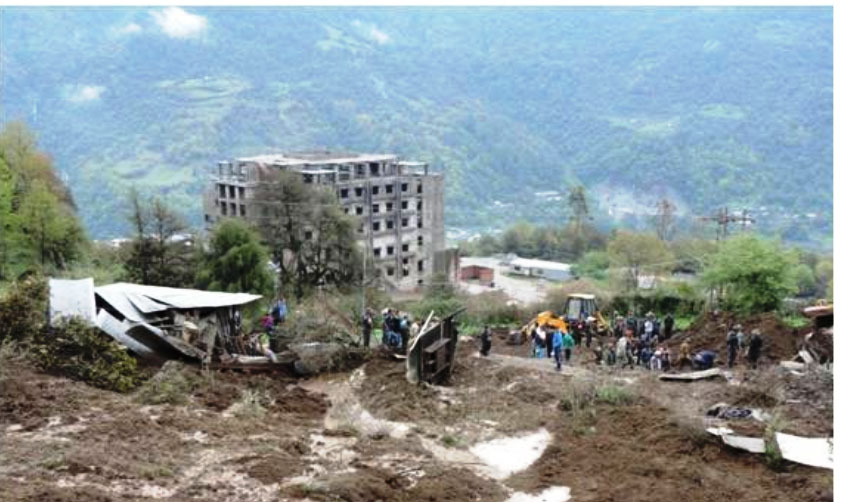
Every Year the North East Region of India is badly affected by several flash floods and landslides of bewildering variety. These landslides cause not only recurring losses of human life’s but also recurring economic losses worth billions of rupees. The driving forces / pressures for flooding and landslides are of natural, manmade and combination of factors which interact in complex ways.
Once instability is introduced, the hill slopes often become chronically prone to landslides. The problem of landslides is aggravated during the monsoon season due to (i) enhanced pore water pressure, (ii) increased weight of the rock mass and (iii) reduced frictional forces. There could be various reasons for such events but the main reason seems to be the inherent geology of the Himalayas and heavy rainfall. Torrential rains, generally called cloudbursts, or extreme rainfall are frequent events in the region. The cloudbursts occur suddenly, and are a short duration.
Natural Causes of Floods:- Most of the rivers in Himalayan terrain flow through narrow gorges abutting moderate to steep slopes, having sharp bends and meet tributaries on steeper slopes. As the river flows downstream the valley becomes comparatively wide and less steep. The occurrence of flash floods, particularly in a narrow river valley, seems to be one of the much feared causes of some of the major cloudbursts or landslides or glacial lake outburst. A high discharge during the summer is an annual feature of all snow fed rivers of Indian Himalayas, which dumps a huge amount of sediment downstream. This melting is mainly due to change in temperature (winter to summer). Flash floods can occur under several types of conditions. Flash flooding occurs when it rains rapidly on saturated soil or dry soil that has poor absorption ability. The runoff collects in gullies and streams and, as they join to form larger volumes, often forms a fast flowing front of water and debris.
Natural Causes of Landslides:- Gravity acting on an over-steepened slope is considered as the primary reason for a landslide, however there are other several other factors:-
- Erosion by rivers create over steepened slopes
- Rock and soil slopes are weakened through saturation by snowmelt or heavy rains.
- Earthquakes create stresses that make weak slopes fail.
- Earthquakes of magnitude 4.0 and greater have been known to trigger landslides.

Landslides can move slowly, (millimetres per year) or can move quickly and disastrously, as is the case with debris flows. Debris flows can travel down a hillside at speeds up to 200 miles per hour (more commonly, 30 – 50 miles per hour), depending on the slope angle, water content, volume of debris, and type of earth and debris in the flow. These flows are initiated by heavy, usually sustained, periods of rainfall, but sometimes can happen as a result of short bursts of concentrated rainfall or other factors in susceptible areas. Burned areas charred by wildfires are particularly susceptible to debris flows, given certain soil characteristics and slope conditions.
Man-made causes:- These are human activities on slopes such as: Construction done without proper engineering and geological inputs, Improper farming practices, Indiscriminate removal of vegetation cover and deforestation, etc. These activities may cause an increase in slope gradient or significant change in surface and groundwater regimes adding to the instability of slopes. Excavation or cuts increase the slope angle if carried out without specialist advise. Mining, blasting rock or reclamation of land can also destabilize slopes. Farming activities on slopes involve removal of vegetation cover usually followed by terracing. Sometimes, farmers burn down vegetation as a convenient method of clearing land for cultivation. Commercial logging results in deforestation.
These activities increase surface run-off of rainwater and expose the soil to erosion. Changes in water regime results in raising or lowering of ground water table. Alteration of surface drainage can also be a contributory factor. Irrigation alters natural surface drainage. Surface run-off of irrigated water on slopes exposes soil under cultivation to erosion. Part of this water is absorbed by soil increasing its weight, which can put an additional load on the slope. Seepage and accumulation of irrigated water on slopes can raise the ground water table. This can also be a result of wastewater discharge, water pipe leakage from permanent and temporary storage facilities such as ponds and subsurface irrigation facilities. Human activity can also lead to the lowering of the water table. Pumping from underlined water supply wells, rapid lowering of water level in rivers, lakes or reservoirs can bring about lowering of the water table under soil.

Combination of factors:- There is the possibility that several natural factors occur simultaneously. In some cases, one hazard triggers another. For example, an earthquake may trigger a landslide, which in turn may dam a valley causing upstream flooding and subsequent dam burst. This will lead to flooding in lower catchment areas.
Another example can be where heavy rainfall is accompanied by cyclonic wind. This can cause wind debris flow and flooding in the same area. Interactive events that occur in sequence may produce cumulative effects that are significantly different from those expected from any single event.
Measures to reduce the likelihood of landslides:- Following are few points need to be considered to avoid any disaster before it happens:-
- Avoid building near steep slopes, close to mountain edges, near drainage ways, or natural erosion valleys.
- Get a ground assessment of your property by an expert structural and Geological Engineer.
- Contact local officials, state geological surveys or departments of natural resources, and university departments of geology. Landslides occur where they have before, and in identifiable hazard locations. Ask for information on landslides in your area, specific information on areas vulnerable to landslides, and request a professional referral for a very detailed site analysis of your property, and corrective measures you can take, if necessary.
- Watch the patterns of storm-water drainage near your home, and note the places where runoff water converges, increasing flow in channels. These are areas to avoid during a storm.
- Learn about the emergency-response and evacuation plans for your area. Develop your own emergency plan for your family or business.
- Be aware that strong shaking from earthquakes can induce or intensify the effects of landslides.
- Have flexible pipe fittings installed to avoid gas or water leaks, as flexible fittings are more resistant to breakage.
- Plant ground cover on slopes and build retaining walls.
- In mudflow areas, build channels or deflection walls to direct the flow around buildings.
- Design and construction of walls and channels strong enough to resist or divert landslides is highly specialized work, best done by qualified structural Engineers.
- Listen to weather forecast on the radio, TV etc. about heavy rains.
- Continuous heavy rainfall during a 24-hour period or a high-density rainfall within a period of few hours has the potential to trigger landslides. This threshold limit may vary depending on the strength of the material and slope gradient.
- Be alert if you are living in an area in which landslides occur regularly.
- Observe the signs mentioned above such as appearance of cracks and their rapid expansion over the slope. They may indicate the possibility of a landslide. Inform the local officials immediately when such signs are recognized.
- Listen for abnormal sounds of soil and rock movement or breaking of trees. They may be associated with landslide movements. Never go closer to observe cracks on the slope. If you spot cracks, inform the local and move out from the area.
Measures to reduce casualties during a Flood/Landslide:- Following are few points need to be considered during Flood/Landslide to minimize losses:-
- Stay alert and awake. Many debris-flow fatalities occur when people are sleeping. Listen to weather forecast on the radio, TV etc. about heavy rains and landslides. Be aware that intense, short bursts of rain may be particularly dangerous, especially after longer periods of heavy rainfall and damp weather.
- Remember that driving during an intense storm can be hazardous. If you remain at home, move to a second story if possible. Staying out of the path of a landslide or debris flow saves lives.
- If you are near a stream or channel, be alert for any sudden increase or decrease in water flow and for a change from clear to muddy water. Such changes may indicate landslide activity upstream, so be prepared to move quickly. Don’t delay! Save yourself, not your belongings.
- Be especially alert when driving. Bridges may be washed out, and culverts overtopped. Do not cross flooding streams. Embankments along roadsides are particularly susceptible to landslides. Watch the road for collapsed pavement, mud, fallen rocks, and other indications of possible debris flows.
- Stay where there are people around you, give and receive assurance and comfort for each other.
- Children may need more care and comfort than normal: answer all their questions as best you can even if they ask the same question more than once. Give assurances that they are safe, and that life will return to normal if we respond well to the present situation. You will need all the strength and energy you have to face the crisis so conserve energy by not engaging in unnecessary and disorganized activity, but do only what is necessary.
- Do things together like cooking, eating, chatting, religious observances which will help you successfully adjust to the crisis situation and live through it.
Conclusion
Although the exact prediction of these Floods/Landslides cannot be made, Geologic Investigations, Good Engineering Practices, and Effective Enforcement of land-use management regulations can reduce these flood/landslide hazards.
About author
The author is General Manager of M. P. Construction Co. with nearly 14+ years of experience in construction projects & leveraging standalone expertise in making timely decisions that positively impact project success. His expertise is Project Execution & Project Management for various Civil Projects Railways / Metro / Bridges / Building / Highway / Airports etc. He is currently handling Chennai Metro Rail project, Western Dedicated Freight Corridor and Railway Line Doubling work of Dound-Kalburgi Section in Solapur Division of Central, Railway-Maharashtra.

